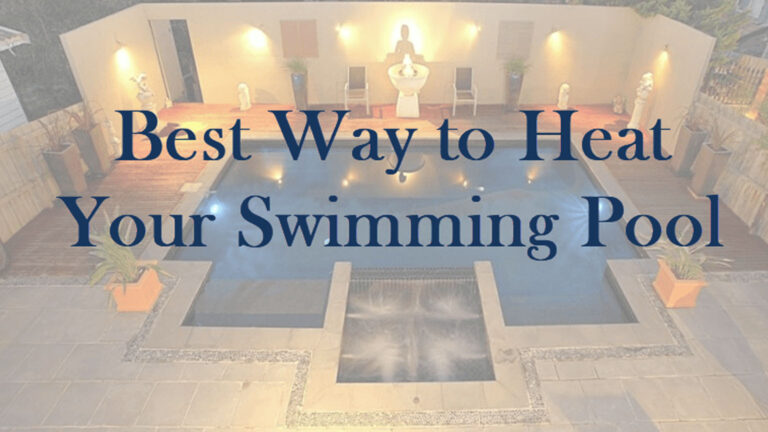Winter’s coming, and that means one thing for so many pool owners: Throwing on the pool cover and saying goodbye to summer fun. But the falling leaves and brisk mornings don’t mean you have to throw in the (pool) towel just yet!
Think heating your pool means talking big dollar signs and doling out cash from your savings? Think again. There are so many different types of heating systems available – electric resistance, gas heat, heat pumps, solar heaters, and some clever DIY techniques, too! Thanks to all these available methods and thanks to new technology, heating your pool has become more easy and cost-efficient than ever before – if it’s done the right way.
Even if you can’t be bothered by the thought of extending your pool season by a few months just for the sake of luxury, think about the other benefits: Most swimmers enjoy swimming in waters that measure around 83+ degrees Fahrenheit. The problem is that some pools never even get above the mid-70’s, even in summer months.
What’s more, that heated water does wonders for joints and your general health. Folks who suffer from arthritis and muscular conditions can benefit greatly from warm water – why do you think so many gyms have hot tubs? And remember, swimming is one of the best cardiovascular workouts – heat your pool, and you can exercise well into fall and early spring.
Table of Contents
Heat Pump vs. Solar Heat
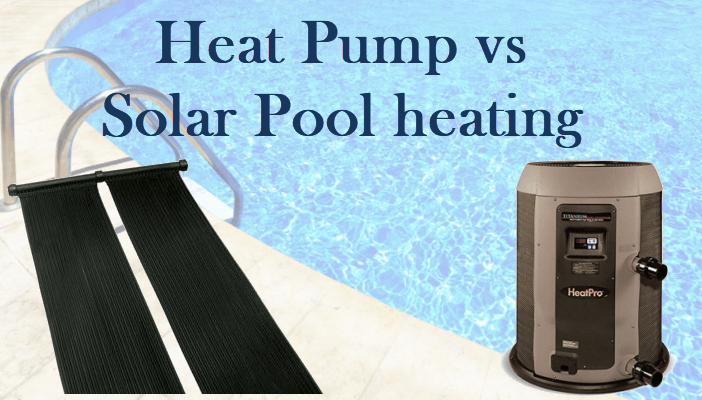
Now that you’re convinced you should heat your pool, let’s discuss the most popular methods:
Heat pumps and solar heaters. Sure, there are other methods of heating your pool (like we mentioned above), but these two methods are generally considered the most reliable and cost-effective.
A heat pump works like this:
Your pool’s water is sucked into the pump, where it passes through the pump’s heater. The heater functions by taking warmth from the outside air or a warm water source (which is surprisingly efficient, even during “cold” days) and converting that energy into electric heat.
That electric heat passes back through the pump into the water, warming it before it circulates back into your pool. Heat pumps are great at maintaining the warmth of your pool even when outside air temperatures are just 45 to 50 degrees. Even for the cold, wet northeast, that means you can enjoy your pool up to around October, and you can that cover off and go for a dip early as March!
Heat pumps are versatile, too – there are numerous installation methods and types of heat pumps that you can choose from, to best suit your property, your budget, and your recreational needs. We’ll dive into those specifics shortly.
If you’re the type who enjoys green energy and a system that’s not reliant on the exterior temperature, a solar heating system may be best for you. Although expensive, solar heating systems are completely self-contained and operate independently of the weather outside (if it’s not completely overcast).
A pool solar heating system, as the name implies, uses the energy of the sun to heat your pool. The heater uses a series of solar collectors that function similarly to actual solar panels. This is obviously a huge benefit when it comes to reliability and operating costs: The sun isn’t going anywhere and the cost of collecting all that energy is free.
Solar heaters can be a little expensive upfront because they require a relatively large array of collectors, and they still require the use of pumps, plumbing, filtration, and other electronics, but their operating costs (or complete lack thereof) and their relatively low maintenance costs quickly outpace that initial investment, especially if you plan to swim often. Most experts say that a solar heater pays itself off as early as a year and a half into ownership – not bad for those extra months of simulated summer fun.
So, which one is right for you? Before you decide, there’s a lot to cover. We’ll go over heating your pool with a heat pump and with solar energy, including installation, start-up costs, and operating costs. We’ll also try to help you decide based on where you live – remember, the weather’s different everywhere you go!
Heating Your Swimming Pool with a Heat Pump
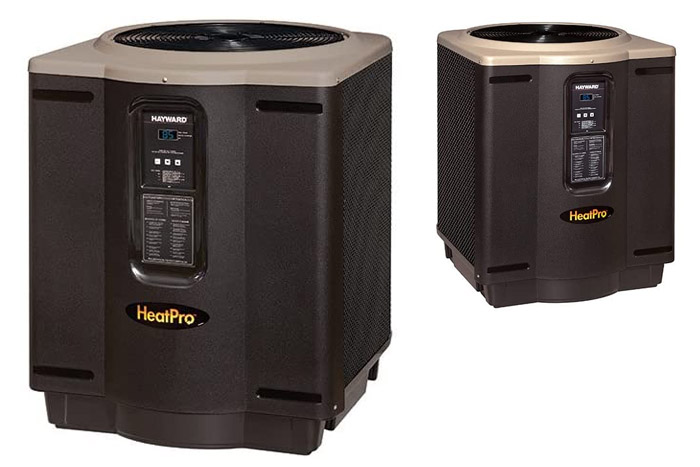
Our brief explanation of how a heat pump works might seem confusing. After all, how does hot water get generated from brisk air or just another body of water? Let’s explain completely. A heat pump uses quite a few components to get the job done.
First, the pump’s heater uses a fan or siphon to draw in the outside air or water. The fan or siphon moves that air or water over an evaporating coil – a hollow set of tubes that contains a refrigerant liquid. Although the outside air or water might feel cold, the coil’s constant absorption of heat produces a compounding effect. As the coil continues absorbing heat, the temperature of the refrigerant rises.
That refrigerant is then fed through a compressor, which in turn creates even more heat. The end result is a very hot gas that’s produced inside the compressor, which then passes through a condenser. The condenser is the unit that moves that hot gas’s energy into your pool’s water, warming it.
To be clear, this is a self-contained system that functions like an air conditioner. There is no need to “fuel” your heat pump like a gas heater. The use of the term “gas” is simply coincidental, but to be clear, they’re completely separate methods of generating pool heat.
Types of Heat Pumps
Not all pool heat pumps are created equal. Mechanically speaking, higher quality and more efficient heat pumps use scroll compressors, while less expensive (and less efficient) units use a reciprocal compressor.
-
Scroll Compressor Heat Pumps
Scroll compressor heat pumps are aptly named: They use two spiraled mechanisms, or scrolls, that create pressure. Inside the compressor, two metal coils are entwined around each other. One coil is stationary, while the other orbits around the axis of the stationary coil. As the two coils press against each other, the refrigerant between the two coils compresses.
Scroll compressors are more efficient for a few reasons: They require fewer moving parts (70%, in fact) and less kinetic energy to operate. They’re also simpler in design and they provide a more continuous method of compression compared to reciprocal compressors. Because of this, they’re also very quiet.
Lastly, they require less physical volume and space to compress refrigerant, inherently increasing their efficiency. That also means your pool’s heat pump, if it a scroll compressor, can be placed in a more convenient location that’s out of sight and sound. -
Reciprocating Compressor Heat Pump
A reciprocating compressor uses a piston that’s actuated by a crankshaft to move refrigerant from a large space into a smaller space, creating compression. A reciprocating compressor requires numerous valves to operate – one inlet valve to allow the refrigerant to enter the compression space, and an exhaust valve to allow the compressed refrigerant to move from its compressed space and into the condenser.
To be sure, reciprocating compressors are still quite efficient and reliable – just not as much when compared to a scroll compressor-equipped heat pump. Not be confusing, but both air-source and water-source heat pumps can use scroll or reciprocating compressors. -
Air-Source Heat Pumps
Air-source heat pumps are extremely efficient and provide low operating costs. They’re more effective in warmer climates and they’re designed to function year-round. An air-source heat pump uses a fan to draw air into the pump and over the evaporating coil.
-
Water-Source Heat Pumps
Water-source heat pumps are generally new in the world of pool heat. They’re not as widely used as air-source heat pumps or other methods of heating your pool, but they’re growing in popularity because they also provide high efficiency and low operating costs.
A water-source heat pump works best for customers who live in colder climates. Also referred to more logically as a geothermal heat pump, a water-source heat pump draws its energy from an external body of water underground. A water-source heat pump can be open looped or close looped.
Open looped heat pumps require two bodies of water, one acting as the source, and one acting as the recipient of the pumped water. Open looped systems are also referred to as deep ground well systems.
A close looped system, called a ground loop, uses just one body of water to draw energy and return the pumped water.
There are also surface water systems and mechanical loop systems that use either an open body of water or a larger air conditioning system to draw energy, but these are very uncommon systems and are often not even available for residential sale.
Installing the Heat Pump System
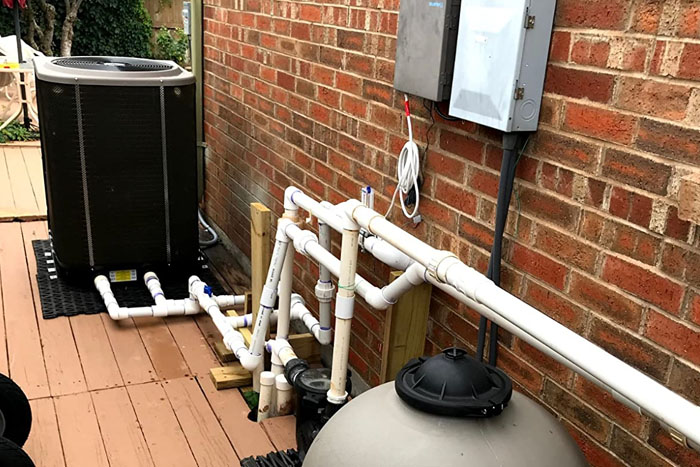
Before installation even begins, you should work with a professional to ensure you’re getting the right unit. Your pool expert will take some critical measurements and consider environmental factors, your property’s setup, and your budget to determine what heat pump is best for you.
To install a heat pump properly, your pool professional will:
1. Ask what your desired pool temperature is
2. Ask what minimum external temperature you’d swim in
3. Subtract the two figure above to determine your “temperature rise”
4. Determine your pool’s surface area and volume
5. Find out how many BTUs of heat your pump will need to produce
Once that’s determined and your unit of choice is ordered, the installation process can begin. It’s so important that your heat pump is installed correctly – failing to do so can drive up operating costs, result in subpar performance, and reduce the life expectancy of your heat pump altogether.
Heat pumps can weigh as much as 350 pounds, so they need to be seated on a rock-solid foundation. If you don’t have a location picked out for your heat pump, plan ahead with your installer, well before arrival. Your heat pump should have ample clearance of space around it. If its confined, it won’t operate efficiently because it will become constricted by the heat the unit gives off. It’s essential your heat pump remain in a temperature-neutral environment, otherwise your coil and condenser won’t function as effectively, and it’ll tax the unit.
• Placement.
A good rule of thumb is that your pump should have 18” of clearance around the sides and back, and 36” of clearance in the front. Most importantly (especially for air-source pumps), you should have a few feet of open air above the pump. Your heat pump should be situated on a flat, hard surface, about 3 to 5 feet in total surface area. This will allow your pump to remain stable and upright without the risk of settling.
• Plumbing.
Your heat pump’s plumbing should travel just a short distance to and from your pool. The longer the distance travelled, the more opportunity there is for loss of heat. Plumbing should also have as few bends, rises, and dips as possible. The straighter the plumbing, the less your pump must work to move all that water. A professional plumber is highly recommended in this instance. He or she will help determine the most efficient and effective method of plumbing to and from your pool.
• Power.
Your heat pump will require ample power to operate correctly. Most heat pumps require a 30- to 50-amp breaker, which can be easily accessed via an outside 100-amp subpanel breaker box (typically installed next to pools to run their filtration systems). You’ll need to determine if you have enough amperage left over after considering your pool’s other systems, which can be done by adding up the amps on the existing breakers in use. If your breaker box can’t handle the load, don’t test it. A professional electrician should be installing your heat pump, and he or she will be able to easily run a dedicated line from your main box.
Cost of Heating a Swimming Pool with a Heat Pump
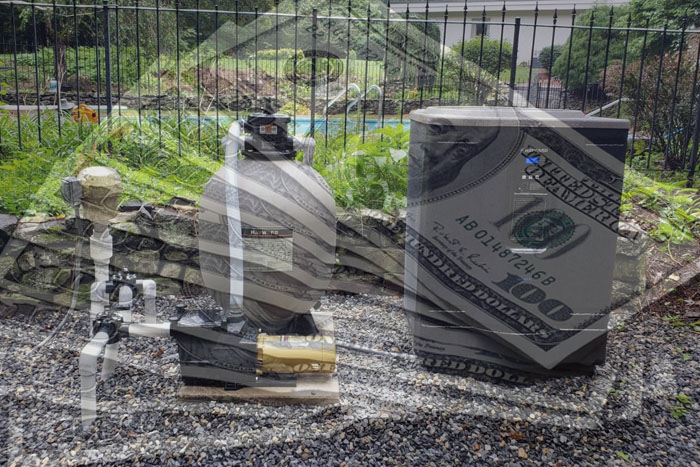
In case you haven’t guess it yet, the installation of a heat pump requires quite a few costs. A professional plumber and professional electrician are both highly recommended for the sake of ensuring reliability, safety, and low operating costs – but those guys and gals cost money to employ. Your heat pump itself is also going to be relatively expensive if you want it to be efficient and long-lasting in its operation.
But that doesn’t mean that the investment is a bad idea. To be sure, a heat pump is one of the most efficient ways to heat your pool, and the operating cost savings compared to other methods will quickly pay for the purchase and installation. With this in mind, the cost of running your heat pump will vary, depending on where you live and the average temperatures in the colder months.
Calculating the initial cost of your heat pump is pretty simple: How much does the unit cost? That’s what you’ll pay, plus the cost of installation and setup. Figuring the operating costs out can be a little bit trickier, though a good pool technician will be able to calculate all that for you. He or she can get very accurate, too – your climate, existing customers, and the advertised efficiency ratings of your pool all boil down to a very specific and well-considered formula.
And remember, the cost of heating your pool with a heat pump will still be dramatically less than what you would incur monthly, if you were to use a propane, natural gas, or standard electric heater. But before we get into the initial costs and operating costs, remember this above all else: It requires the opinion of an expert calculating your pool and heating needs to ensure you’re paying as little as possible, while still being able to enjoy your pool the way you want to.
For those interested, the official formula for determining the output requirement of your heat pump (which will guide you along the road to buying the right unit, which will then provide you with a good monthly operating cost) is as follows: Pool Area x Temperature Rise x 12.
Pool area refers to the total surface area of your pool. Temperature rise refers to the difference between your desired pool temperature, and the ambient temperature outside. The factor of 12 is simply part of the formula used to determine total output required. Output is measured in BTUs and horsepower.
The horsepower rating of your heat pump will determine how quickly it can cycle water – the more horsepower, the more your heat pump can move water. You’ll need more horsepower for a bigger pool. BTUs are a measurement of energy that typically accompany heaters and air conditioners. The same concept applies to pool heat pumps. The more BTUs, the more total heat output.
Initial Setup
To put it simply, a good heat pump for an average-in-size pool will cost you about $2,500 to $3,500 for the unit. That sounds like a lot of money, and it may very well be – but consider the long-term operating costs in comparison to other methods. The heat pump itself will still cost less over a period of time than nearly any other heating method.
With that said, let’s look at all the initial setup costs. For starters, the heat pump must be delivered to your property. Remember that heat pumps can weigh as much as 350 pounds, so shipping will usually be completed by freight. Because of this, shipping costs could exceed $100 – though most companies offer free shipping with limited exclusions.
Once your heat pump is delivered, it must be placed in its permanent location and then the plumbing and wiring processes can begin. Although a heat pump can be hooked up to your breaker relatively easily, the risk of shock – and thus injury or death – is too great to consider installing your heat pump’s electrical connections yourself.
Electrical bonding is a critical step in ensuring the safe operating of electrical equipment around your pool. Bonding creates an electrical equilibrium around your pool. If your pool’s equipment was un-bonded, then you could potentially create a circuit between your body, electrical equipment with higher voltages, and equipment with lower voltages. Electrical bonding is necessary for your heat pump.
With that said, the cost of a professional electrician hooking up and bonding your heat pump will vary, but you can expect to pay about $250 to $300. That price will also ring true for the average cost of your heat pump plumbing work. As long as your heat pump is within a reasonably close distance of your pool (as should be the case for the sake of efficiency), you can expect to pay no more than $300 for the plumbing setup.
Keep in mind, though, these are averages. If you elect to install a less common heat pump that uses geothermal energy or a body of water separate from your pool, costs may increase quite a bit.
Running Costs
Here’s where the entire reason you’d want a heat pump to heat your pool comes forth: Low operating costs. The average heat pump will operate more efficiently than nearly any other method of heating (save for solar heat). The short and sweet of it is this: Heat pumps cost about $50 to $150 a month to operate. That average holds true for air- and water-source pumps.
Gas heaters cost about twice as much – around $200 to $400 a month, depending on your local gas rates and the size of your pool. Nonetheless, that’s a pretty solid average to consider when you’re comparing operating costs.
Electric resistance heaters cost even more – around $500 to $600 a month. We find that monthly cost to simply be unreasonable, no matter the benefit. They’re simply not energy-efficient by any measure, and their installation costs are equally exorbitant.
Even if the monthly operating cost of your heat pump seems too high for you to bother investing, you should consider the benefits of a pool cover, solar cover, or liquid solar blanket. These quick and easy-to-install covers will help your pool retain much of the heat that’s generated by your heat pump. This will reduce operating costs dramatically – up to 75%. These covers will allow your heat pump to reach the desired temperature and then shut off for longer periods of time.
When the temperature drops, your pool will also regenerate that lost heat quicker, suffering little parasitic loss of heat to the outside environment while your pump works to reach temperature.
Heating Your Pool with Solar Energy
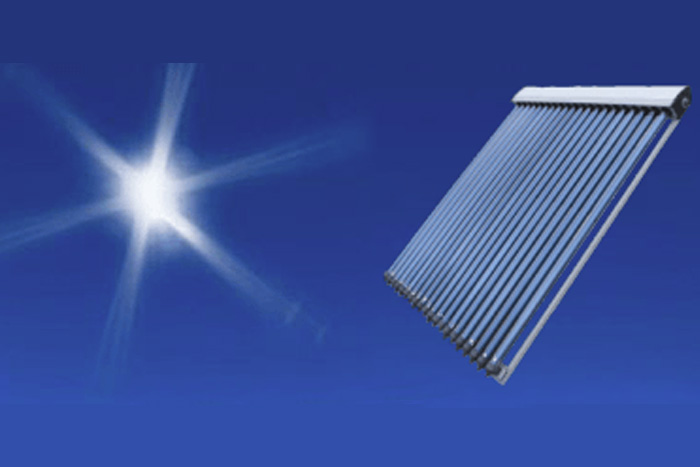
First, there are some misconceptions about pool solar heaters to clear up: The component that arguably matters most, the solar collector array, is not built like a traditional set of solar panels that are used to power your home. The collector is not a set of photovoltaic panels that generate electricity.
With a quick glance they appear very similar. But solar collectors are actually much less expensive than conventional solar panels because they don’t use electricity to generate heat – they simply absorb the sun’s raw energy and use it to heat your pool water directly. They don’t require glazing or insulation either, because once the actual winter freeze comes, your solar array will not be in use. Instead, they’re made of heavy-duty, black polymer material that is highly solar-efficient (70% to 80%) in collecting heat.
metal collectors are available, too. They’re commonly built using copper tubing that’s mounted on an aluminum plate. Aluminum is the metal of choice because it won’t rust or corrode like steel, and it doesn’t require expensive treatments to withstand the elements.
So how does it all work? The solar heater uses a series of sensors, tubing, paneling, and pumps to heat your pool water. First, you set the desired temperature on your pool-side thermostat. The solar heating system then goes to work, turning on a pump to cycle your pool’s water.
That water gets sucked out of your pool, through a series of tubing, and through your solar collector. The solar collector functions kind of like a radiator. Tubing inside the array loops back and forth numerous times across a heat-absorbing base. This heats your pool’s water.
The heated water is then transported back into your pool until the desired temperature is reached. Once your pool’s at temperature, the solar system’s sensors shut off the pump. This is a relatively simple system in mechanical nature, though its highly effective and reliable. Even during cold months, as long as the temperature is above freezing, your solar heater will be able to maintain a relatively warm pool temperature that’ll allow you to extend your swimming time by up to 6 months.
Heating your pool with solar energy will make for a huge payoff pretty quickly. Where other pool heating methods easily cost a minimum of $50 per month (though frequently much more – usually double, or triple that), you’ll be getting free energy from the sun. Your only costs will be your initial installation costs. Though they can be higher than other pool heating methods, you’ll beginning paying for that cost immediately.
The environmental benefits of a solar heating system are great, too. You’ll save an average of 140 tons of greenhouse gas emissions compared to a heat pump, and you’ll save over 160 tons of greenhouse gasses compared to a gas heater, over the life of your pool. We’ll get into the different solar heating options and their associated costs, but up front we can say you’ll save around $18,000 to $36,000 over the life of your pool when compared to other heating methods.
Solar Heating Options
The nice part about solar heating systems is their modularity. Although solar collectors are generally large – they have to be, to absorb enough heat for your pool – there are so many different options available on the market when it comes to installing your solar collectors.
- Pool-side Flat Panels
If your property allows for it, you can set up a solar collector array that’s right beside your pool. This array can be modified to be completely square, or long and thin – whichever works best for your property. Because these panels rest directly on the ground, they can be easily hidden some simple landscaping or hardscaping. They can even be hidden behind your pool if it’s above ground.
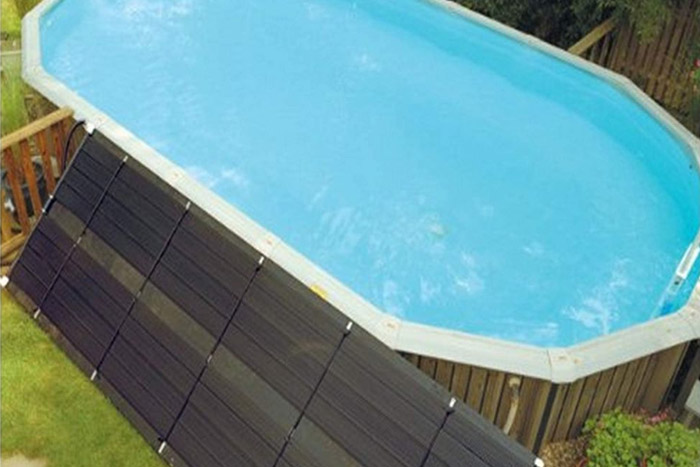
- Multi-level and Dome Panels
Although generally suited for smaller pools (30 to 50 square feet) these solar collectors are ultra-compact and efficient. They Feature multiple layers of panels that compound the sun’s heat. Dome panels feature spiraled tubing inside that compacts plenty of volume into a small space, providing ample heat without much physical area required.
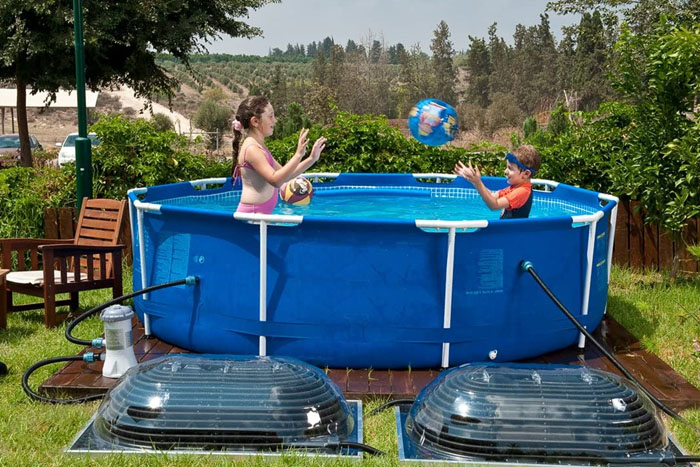
- Rooftop Panels
These are the most desirable solar collector arrays when it comes to heating your pool with solar energy. Flat, black, and out of the way, they resemble conventional solar panels, so they don’t stick out like a sore thumb. Their optimal positioning on your roof means they’ll gather as much heat as possible for the longest amount of time per day. These panels guarantee the most efficient and effective solar heating solution for even larger pools, and this is the method we recommend investing in.
Regardless of the solar collection method you invest in, there are some best practices you should follow to ensure your new system functions efficiently. That means orienting and tilting your solar array toward the sun. The best orientation is south-facing, where your array can absorb sunlight from morning to evening. West-facing orientations are satisfactory for heating as long as the collector area measures around 75% of your pool’s total surface area.
Tilting your collector to face the sun appropriately is important, too. Your collector should be as close to perpendicular to the sun’s rays as possible – and that doesn’t mean facing it straight toward the sky. Instead, you’ll want your collector facing around 10 to 15 degrees off vertical.
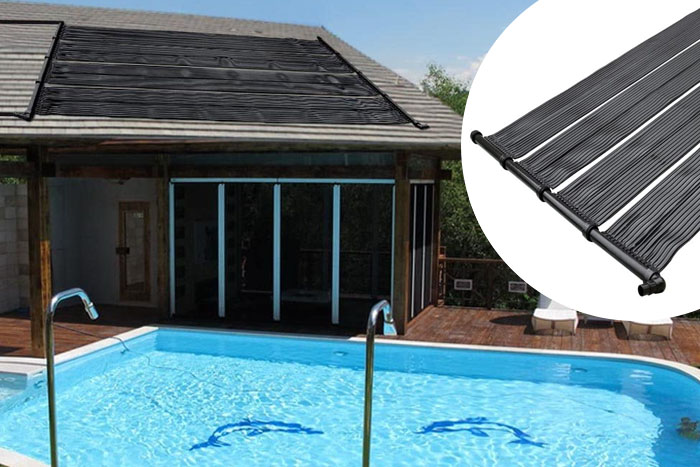
How to Heat Your Swimming Pool for Free
Heat pumps and solar heating systems cost money to setup, and although solar is free to operate, many can’t stomach that initial setup cost – especially considering the dollar amount will likely include a comma in the figure.
With that said, there are some pretty creative ways you can heat your pool basically for free:
Build your own solar heater!
That sounds like something an engineer might do in his spare time for the fun of it, but it’s actually not that difficult to build your own. All you need is an old sliding glass door, some wood boards, some copper tubes and sheets, and PVC piping to put it all together.
The wood will function as your collector box, while the copper piping and sheets will function as the heat absorbers. With a little bit of patience, you can solder those copper parts into a functioning (and highly efficient) solar array. Splice the plumbing in between your pool’s pump and return line, and you’ll have your own home-built solar heater.
Filter your water with black hosing
Okay, so many building your own copper-and-wood solar heater is a little advanced. You don’t have to go that crazy, but you can still enjoy the same free pool heating method using some black hosing – a lot of it, in fact.
If you’ve ever gone to water the garden on a summer day with a black hose, you’ve probably felt how hot they get in the sun. You’ve probably also realized how hot the water inside that hose gets when sitting. Well, that concept can be used to heat your pool. By purchasing some large-diameter black poly tubing and coiling it in the sun next to your pool, you’ll have created a simple but effective solar collector.
Run a simple siphon from your pool, into the tubing, and back into your pool, and you’re set! The whole production should cost less than $100. Although this won’t be as efficient as an actual solar collector system, it will provide you with a modest 4- to 7-degree pump in temperature on sunny days!
Make your own solar discs
Pool solar blankets or solar pool covers are nifty little inventions that keep the heat generated during the day, in your pool overnight. Some solar blankets can actually act as warming devices, collecting solar heat and transferring it into your cooler pool water, kind of like a magnifying glass. You can spend the cash to get one made by a pool accessory company or buy a premade one online, though with a little ingenuity you can actually make solar discs that function the same way!
All you need are some black trash bags and hula hoops. First, cut your trash bag down the side and bottom seam, so it opens flat. Place a hula hoop on top of the flattened trash bag. Cut the trash bag around the edge of the hula hoop, leaving about 3” of extra material.
Once cut, take the extra material and wrap it around the hula hoop. Using waterproof tape or glue, secure the excess bag material around the hula hoop. The end result should be a round, floating black disc that’ll float atop your pool and collect sunlight, heating your pool water. Make enough to fill your pool and leave them in for a few hours, and you’ll raise the temperature quite a bit.
Hopefully today’s post has got you on the right path to a nice warm pool at an affordable cost all year round! If you have any questions or thoughts feel free to comment below or send us an email.

